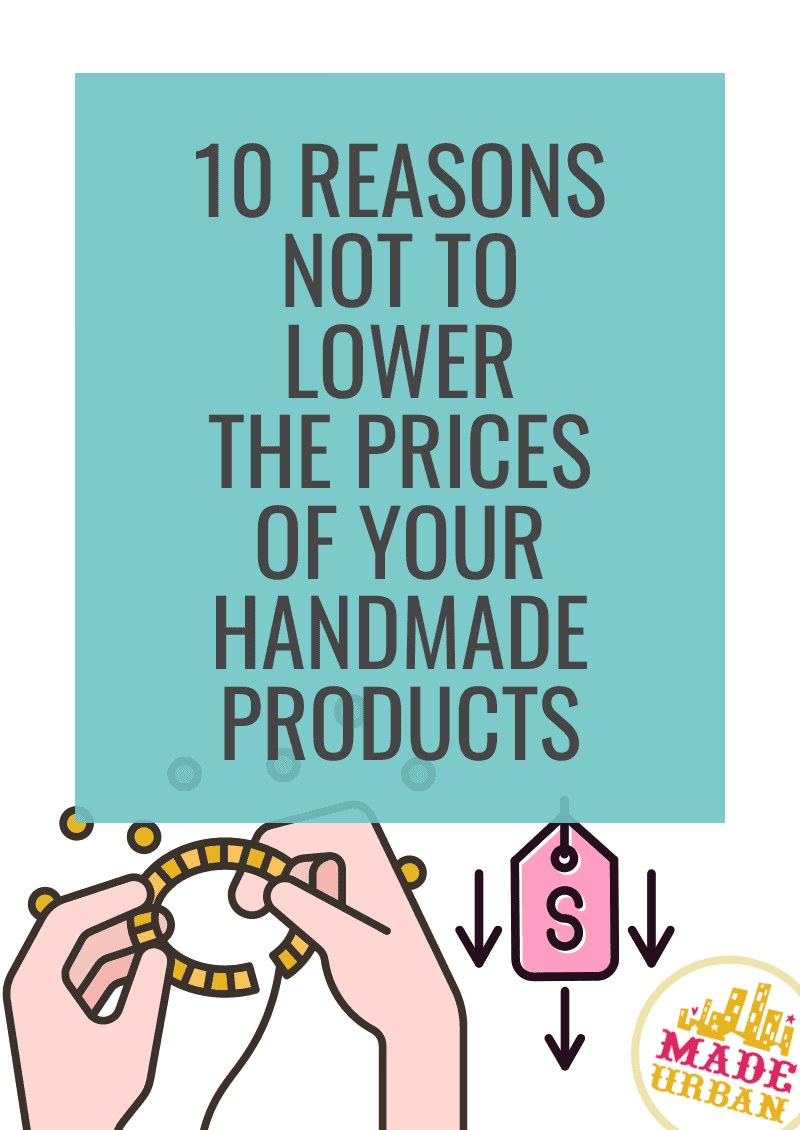10 Reasons NOT to Lower the Prices of your Handmade Goods
How you price your products can make all the difference in whether your business is going to be successful or not.
I’ll assume you’ve priced your products properly to cover your hours, costs, markup and profits (if not, follow this pricing guide: The Right Way to Price a Handmade Product (Step-by-Step Formula)).
But if you’re thinking about lowering your prices because they seem too high, or in an attempt to boost sales, consider these 10 reasons not to.
1) Your business won’t last
If you lower your prices without considering profit margins, it’s likely your business won’t last very long. Every business needs healthy profit margins to be able to:
- invest back into the business and grow it
- cover slow sales periods
- allow the business owner to take breaks
- keep motivation going
If you’re simply putting time and money into your business only to earn that money back (without any extra on top), you’re more of an employee of your craft business and may lose motivation.
2) You’ll be lowering the perceived value of your products
If you buy a bag for a few dollars, how long might you expect that bag to last? Would you expect the material and craftsmanship to be of high quality? Probably not. When you price your products lower than average, it can lead shoppers to think there must be something wrong with it, or that it’s not high-quality.
3) It’s hard to change first impressions
If you come on the scene charging low prices and shoppers believe your products are lower quality, it will be hard to change that impression and eventually charge higher prices.
4) You’ll attract the wrong customers
As a handmade business, you don’t want to attract bargain shoppers. You want shoppers who appreciate the value of a handmade item and want to come back and buy from you again and again. Bargain shoppers don’t tend to be loyal to a brand; they’re going to buy from whoever has the lowest price.
5) You may ultimately lose customers
Keeping in mind that you can’t underpay yourself forever, you’ll have to eventually raise prices. You’ve done all this work to attract customers…but they expect low prices. So guess what will happen when you raise them? Chances are, they won’t stick around and you’ll be back at square one, building a new customer base from scratch.
6) You may be harming other craft businesses
If you’ve calculated prices properly, you likely came to a similar price your competitors did. If a consumer sees two similar products but one is half the price, they’re going to think the higher priced item is overpriced (which it’s not). If everyone starts lowering prices to compete for sales, no one is being paid fairly.
7) You’re sending the wrong message to yourself
Have confidence in your work. If you’re starting your business thinking that you or your products aren’t good enough to charge these prices, you’re putting yourself at a disadvantage. Believe in what you’re doing; it will come through in your attitude, your business and your products.
8) You won’t be able to sell wholesale
If you plan to sell your products outside of craft shows and your website/social media platforms, you’ll probably venture into selling wholesale. Retailers expect to purchase your products at 50% of the retail price. If you start lowering that retail price, you may still make a nice profit when you’re selling directly to consumers, but you’ll probably lose money when you sell wholesale (and you can’t have a lower price at craft sales than your retailers are selling your products at. That’s not fair to them and you’ll eventually burn your business bridges.).
9) You’ll have to work harder for your profits
It’s much easier to sell to one shopper than it is to sell to 10. So you want to make the most of each sale. If you lower your profits from $10 per sale to $1 per sale, you’ll have to make 10 sales to keep your profits up.
10) You’re taking away from the handmade experience
Generally, people who shop handmade aren’t looking for a cheap deal, they’re looking for value and a different experience than they would get shopping with a major retailer. If you lower your prices, you’ll have to start to cut corners and won’t have the time or money to create unique, quality items, or to put time and money into details that are important (e.g. branding, craft show display, online shop maintenance, etc.).
Follow this guide to ensure you’re pricing your handmade products properly: The Right Way to Price a Handmade Product (Step-by-Step Formula)
And if you need to lower your prices, find ways to lower your costs: How To Lower Production Costs to Increase Profits


Hey, I’m Erin 🙂 I write about small business and craft show techniques I’ve learned from being a small business owner for almost 2 decades, selling at dozens of craft shows, and earning a diploma in Visual Communication Design. I hope you find my advice helpful!

2 Comments